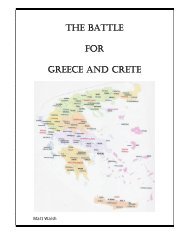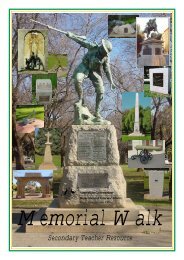Eastern Adelaide Teacher resource.pdf - Army Museum of South ...
Eastern Adelaide Teacher resource.pdf - Army Museum of South ...
Eastern Adelaide Teacher resource.pdf - Army Museum of South ...
Create successful ePaper yourself
Turn your PDF publications into a flip-book with our unique Google optimized e-Paper software.
<strong>Teacher</strong>s information on the Seige <strong>of</strong> Tobruk<br />
Tobruk, like Gallipoli, is a name that means much in the war<br />
annals <strong>of</strong> Australia. Between April and August 1941 up to<br />
14,000 Australians, under the command <strong>of</strong> Lieutenant-<br />
General Leslie Morshead, were besieged in Tobruk by a<br />
German-Italian army commanded by General Erwin Rommel.<br />
The Allied garrison, largely Australian, grimly defended the<br />
strategically important fort. At night, the Royal Navy and the<br />
Royal Australian Navy service kept the garrison supplied by<br />
means <strong>of</strong> the "Tobruk ferry" which included the Australian<br />
destroyers Napier, Nizam, Nestor and Vendetta that were also<br />
known as the “scrap iron flotilla” due to the age <strong>of</strong> the ships.<br />
The German propagandist Lord Haw Haw (William Joyce) derided the allied troops<br />
as the "Rats <strong>of</strong> Tobruk", because they lived underground during the day to escape<br />
bombing raids by German aircraft. The term “rats” was proudly embraced by the<br />
defenders <strong>of</strong> Tobruk as an ironic compliment.<br />
Tobruk was a nut the Germans and Italian forces could not crack. Its defence held up<br />
Rommel’s advance towards Egypt and the vital allied sea link the Suez Canal. If<br />
successful in his North African campaign, Rommel then could have advanced further<br />
east and threatened the Middle East oilfields. Under the inspired leadership <strong>of</strong> the<br />
Australian General Morshead, <strong>of</strong>fensive tactics achieved the task <strong>of</strong> defending<br />
Tobruk. These tactics included regular night patrols deep into enemy held territory. Its<br />
defence was a thorn in the side <strong>of</strong> the German army, upsetting not only plans for an<br />
attack on Egypt, but also giving the allies time to build up its forces for a counter<br />
attack. This occurred in November 1941 and the siege at Tobruk finally ended after<br />
242 days when the garrison broke out to join up with the British Eighth <strong>Army</strong>, which<br />
affected the relief <strong>of</strong> Tobruk on 10 th December 1941. The Australian casualties at the<br />
siege <strong>of</strong> Tobruk were 3,009 killed or wounded and 941 taken prisoner.<br />
Source: www.awm.gov.au/encyclopedia/tobruk/<br />
<strong>Teacher</strong>s note: William Joyce was executed after the war for his treasonous<br />
propaganda.<br />
Peter Frederick Newman was a Lance Corporal with the <strong>South</strong> Australian 2/27 th<br />
Battalion, which was involved during the final stages <strong>of</strong> delaying <strong>of</strong> the Japanese<br />
advance along the Kokoka track at Efogi and Brigade Hill in September 1942.<br />
<strong>Teacher</strong>s information on the Kokoda Track<br />
In July 1942 the Japanese landed troops at Buna and Gona on the Papuan north coast.<br />
Their plan was to capture Port Moresby. The barrier between the Japanese forces in<br />
the north and Port Moresby on the south coast was the Owen Stanley Range - a steep,<br />
rugged series <strong>of</strong> mountains crossed only by a few foot tracks, the most important <strong>of</strong><br />
which was the Kokoda Track. At the end <strong>of</strong> June, one thousand Australian militiamen,<br />
‘Maroubra’ Force, had been ordered to hold Kokoda and its airfield against any<br />
possible Japanese attack.<br />
45











